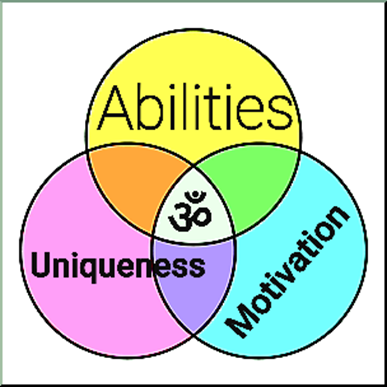AUM-GROW: Improved GROW model for Personal Development process PDP
AUM-GROW: Improved GROW model for Personal Development process PDP
The GROW model has two parts:
Looking back:
Goals & Reality
Looking
Forward: Options & Way forward
The AUM model is made
of three cycles: Abilities, Uniqueness and
Motivation.
Self-realization is identifying our Abilities, Uniqueness and Motivation.
Nir Golan,
Educational & Leadership expert, combined between the GROW model and
the AUM model, and created an improved model AUM-GROW: model for
individual GROW- Personal Development process PDP
Aum ॐ is a sacred sound and a spiritual symbol in Indian religions.
It signifies the essence of the ultimate reality, consciousness, or Atman.
More broadly, it is a syllable that is chanted either independently or before a
spiritual recitation in Hinduism, Buddhism, and Jainism.
The organismic theorist Kurt Goldstein coined the motive to realize one's
full potential: self-actualization. Self-realization is to know
oneself. The term can be traced to Advaita Vedanta which means to realize the
truth of one's existence. Nir Golan, Educational & Leadership expert,
suggests using Dobeing instead of two terms: Doing and Being. Dobeing means
to do my being.
The AUM model:
Dobeing is the heart of three cycles: Abilities, Uniqueness and
Motivation.
Self-realization is identifying our Abilities, Uniqueness and Motivation.
· Abilities:
Skills I'm good at and I do the best.
· Uniqueness: My
significant behavior and added value to those around me.
· Motivation: The things
I like to do most and excite me.
Dobeing is realizing one's full potential according to these three cycles.
Dobeing is a combination between Self-realization and self-actualization.
In Goldstein's view, it is the organism's master motive, the only real motive:
"the tendency to actualize itself as fully as possible is the basic
drive... the drive of self-actualization." The only way to
"actualize itself" is by using the motivation that you must
do what you do best and spread your uniqueness all around. Carl
Rogers similarly wrote of "the curative force in psychotherapy
- man's tendency to actualize himself, to become his potentialities... to
express and activate all the capacities of the organism."
Dobeing is a combination of doing and being, therefore it is a new term. Golan
assumes that these two terms should be fused and not use as a conflict term.
Dobeing is to express and activate all the Abilities, Uniqueness
and Motivation of the organism- the AUM model.
5 AUM-GROW
Steps:
I.
AUM self-identification using the
AUM self-questionary
Identification of three cycles:
Abilities:
Skills I'm good at and I do the best.
Uniqueness: My
significant behavior and added value to those around me.
Motivation: The
things I like to do most and excite me.
II.
AUM-Goals: review the individual
goals:
If there are
no goals- recreate them.
It they are
not relevant anymore, update them.
The goals should
describe behaviors, standards (quality & quantity), and timeline.
1. What individual goals do you want to
achieve? (Make sure they are specific, measurable, action oriented, realistic)
2. What do you hope to fulfill in yourself
through this goal?
3. Why do you think this goal is meaningful for
you?
4. Which of your individual values relative to this goal?
III.
AUM-Reality check: evaluation of
the degree of achievement of the individual goals.
Gaps: low
achievement (partial, not according to the standards).
Success: high
or outstanding achievement (full, above expectations).
Reality should
be introduced using facts, examples, quotations and other data.
Analyzing the
reason for the gaps/ success:
Discussion
with the person to identify the main reason for his behavior:
· Gap: 4 optional reasons:
Knowledge:
"I didn’t know that…"
Awareness:
"I didn’t pay attention/ notice, I wasn’t aware…"
Attitude/
Opinion: "I don’t agree/ accept…"
Skill: "I
didn’t know what to do/ how to deal with it…"
· Success: 4 optional reasons:
Knowledge:
"I knew that…"
Awareness:
"I paid attention, I noticed, I was aware…"
Attitude/
Opinion: "I agree/ accept…"
Skill: "I
knew what to do / how to deal with it…"
1. What is happening regarding this individual
goal right now?
2. What has stopped you from reaching this
individual goal before?
3. Do you know of someone who has achieved this
individual goal?
4. What can you learn from him/ her?
IV.
AUM-Options: what directions can
you take to close the gap/ preserve success?
It's an option
to revisit the goals- add/ remove/ update.
1. What could you do as a first step?
2. What would happen if you did achieve your
individual goal?
3. What has worked for you in the past?
4. Who can I support you in making this change?
· The type of gap and the ways to address
(change/preserve the pattern or behavior)
Knowledge:
Provide person with the necessary information
Awareness:
Give the person examples, evidence of the pattern/ behavior. Explain to him the
rational, the ‘why’. Give him some practical tips that will help him to pay
attention, be aware to this pattern/ behavior.
Attitude/
Opinion: Explain the rational, the ‘why’, use techniques for changing the
attitude/ behavior.
Skill: Tools, practical tips. Exercise/ practice them.
V.
AUM-Way forward: set concrete
action/ plan.
Wrap up:
Summarize and express your support, define action items, document highlights
and next steps.
1. What action will you take and when?
2. What individual obstacles do you expect to
encounter and how will you overcome them?
3. What resources must you have to achieve this
individual goal?
4. How can I help you to move forward?
·
Documentation:
Date/ Issue/
Feedback given/ Response of person/ FU action/ FU date
Summery
AUM-GROW model is about the significant
learning of the individual in order to reformulate his unique identity because
each person is unique, and no previous theory applied to all people.
The AUM-GROW model assumes that the distinction between children and adults is no longer relevant in the digital age and that each person should be treated as a 'whole' individual person.




תגובות
הוסף רשומת תגובה